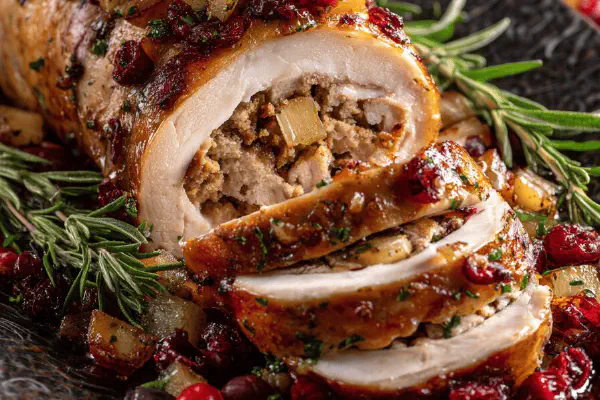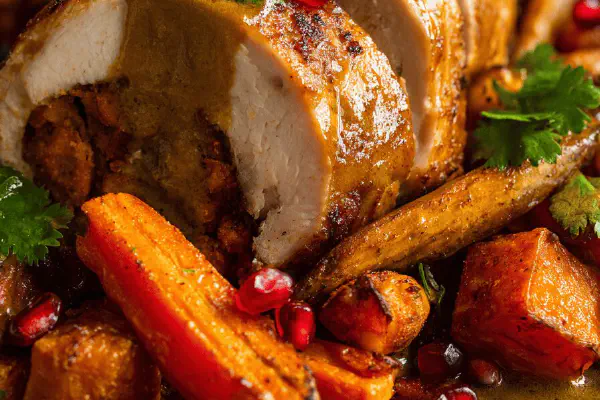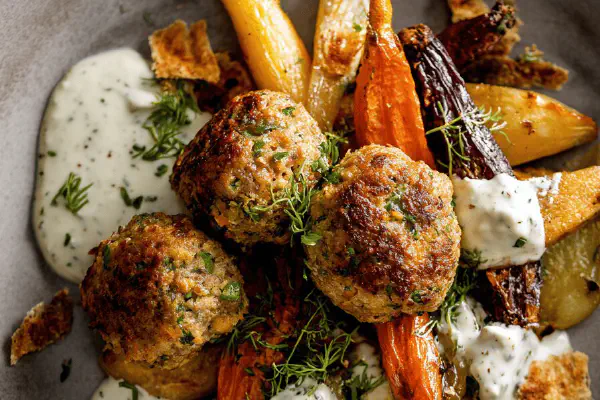Turkey Roast Stuffed Pears

By Emma
Certified Culinary Professional
Ingredients
STUFFING
- 65 g fresh or frozen cranberries
- 1 medium yellow onion finely chopped
- 2 cloves garlic minced
- 25 ml unsalted butter
- 200 g lean ground pork
- 15 ml olive oil
- 200 ml diced peeled pears
- 60 ml dry white wine or substitute apple cider vinegar
- 60 ml chicken broth or vegetable broth
- 30 ml fine dry breadcrumbs
- 1 pinch ground allspice
ROAST
- 1 whole skin-on turkey breast roast about 2 kg, without fillets
- 30 ml olive oil
About the ingredients
Method
PREP STUFFING
- Start heating a heavy skillet on medium-high. Melt butter, toss in cranberries, onions, garlic. Cook till cranberries pop – listen for that quiet burst, soft edges showing, about 5 min total. Salt and pepper now. Lift out to a bowl.
- In that same pan, add olive oil. Break up pork, brown over medium heat, stirring. Watch for light golden edges, not dark brown—that's bitterness. Season. Add pears, cook 3-4 minutes until pear pieces soften but still keep shape.
- Pour in wine and broth. Let simmer, reduce close to dry; should coat bottom with sticky bits - those caramelized juices seal in flavor. Stir in breadcrumbs and allspice for a mild warm note replacing nutmeg. Add cranberry mix back in, adjust salt and pepper. Cool, cover, refrigerate at least 1 hour. Cold stuffing slices easier, flavors meld better.
ROAST PREP
- Bottom rack of oven is best spot. Preheat to 210°C (410°F).
- Unfurl turkey breast. You want that open flat slab. Tuck kitchen twine under every 4-5 cm along length, strings left long on ends. Salt and pepper meat well. Spread stuffing evenly down center - no gobbing, keep flat layer.
- Fold folds back over, secure tightly with twine, cut off excess string. This keeps stuffing tight, even heat, no splay during roast.
BROWNING AND ROASTING
- Warm a large skillet on medium-high till shimmer. Olive oil goes in, swirl. Place the roast down, sear all sides till golden; look for crisp outer texture, rich color about 7 minutes total flipping carefully. Season lightly while browning.
- Into the oven, 15 minutes at high initial heat locks skin, starts crisping fat under that thin surface. Then drop temp to 160°C (320°F). Roast another 1 hr 50 min to 2 hr. Internal temp tip - 74°C (165°F) is safety sweet spot. But check a few spots since stuffing alters heat spread.
- Pull out roast, tent with foil, resting 10 min. That's the pause that lets juices redistribute, stuffing firms up. Use kitchen scissors or thin knife to cut twine while slicing into thick medallions, leave strings on uncut parts to avoid collapse.
- Serve slices with tart cranberry sauce or herbed green beans. Ideal with any roast potatoes or squash mash.
TIPS & VARIATIONS
- If white wine not on hand, apple cider vinegar watered down 1:2 adds bright tang but less sweetness. Vegetable broth instead of chicken works for lighter taste. Butter for browning gives richer mouthfeel but replaced totally by olive oil if dairy avoided.
- Stuffing slightly wet? Add a tablespoon more breadcrumbs, or toast dry bread cubes to soak up moisture.
- Don’t skip chilling stuffing. Raw meat holding inside roast longer can cause uneven cooking and temp spikes.
- Searing seals in juices but watch oil temperature, too hot scorches, too low makes grey crust. That smell — burnt oil — no good.
- Ficelle technique important for presentation and keeping bite uniform.
- If oven too small for big roasts, slice turkey breast in half horizontally then roll and tie individually.
- Keep an eye on juices dripping in pan. If smoking or burning, lower oven temp or add splash of broth after first hour.
- Use instant-read thermometer placed in thickest part near center stuffing for safety check.
- Leftover meat–great in salads or sandwiches with mustard-pear jam twist.
Cooking tips
Chef's notes
- 💡 Start heating pan medium-high, butter melts quiet. Cranberries soften; wait for soft pop — subtle crack, not loud. Watch color, edges soften but intact. Remove early or bitterness grows. Pork browns in same pan, crumble consistently, avoid big chunks. Target light golden, not dark brown—burnt signals off taste. Add pears only when pork nearly browned; softens 3-4 minutes, hold shape. Wine and broth reduce to sticky glaze; watery mix = soggy stuffing. Breadcrumbs stir in quickly—bind but no lumps. Chill stuffing one hour or longer; firmness helps rolling, stops heat pockets during roast.
- 💡 Oven preheat key: bottom rack, full temp 210°C. Sear turkey in olive oil—warm pan first, shimmer. Brown all sides carefully, about 7 minutes total. Crisp skin needs hot pan, steady flip, mitts handy for stability. Season lightly right after sear. After sear, drop oven heat to 160°C for slow roast. Temperature timing varies; check internal 74°C for safe doneness, probe stuffing center multiple spots. Rest 10 minutes tented with foil – juices redistribute, stuffing firms. Cutting through twine neat slices without crushing. Keep strings on areas uncut for shape integrity.
- 💡 Substitutions practical: white wine swap with apple cider vinegar diluted 1:2 water; adds tang, less sweet. Vegetable broth instead of chicken changes flavor but lighter body. Butter in sauté gives richness, swap all olive oil if lactose avoider – reduce quantity slightly to prevent oily taste. Add extra breadcrumbs if stuffing too wet; stale toasted cubes soak moisture. Don’t skip chilling—raw meat warm inside messes cooking with temp spikes. Watch oil temperature while searing; too hot burns, too low dull crust. Observe smell—burnt oil hurts outcome immediately.
- 💡 Ficelle tying technique holds stuffing compact, helps uniform roast shape. Too loose stuffing means uneven cook and open pockets. If oven space tight, slice turkey breast horizontally, roll and tie pieces individually. Monitor pan juices while roasting; smoke or burning means drop heat or add broth splash after first hour. Instant-read thermometer essential. Insert thickest part near stuffing center. Leftover slices great for sandwiches with mustard-pear jam or salad bits. Chill or freeze asap to maintain moistness and safety.
- 💡 Chilling stuffing helps flavors meld, but timing flexible. Longer rest better for texture but don’t forget. Watch cranberries pop—sound subtle but timing sharp. Pear pieces soften to fork tender not mushy. Breadcrumb texture important: too fine soaks too much juice, course clumps won’t bind. Use moderate size crumbs. Allspice replaces nutmeg—gentle warmth, no overpower. Roasting temp drop slow cooks through without drying. Resting important for juicy finish. Slice slowly; twine cuts with small sharp scissors avoid collapse. Serve with tangy cranberry relish or herbed green beans for contrast.
Common questions
Can I use chicken breast instead?
Yes, similar but smaller size, shorter cook time. Watch temps carefully, less cooking time means less dry. Stuffing still same but check internal temp near 74°C. Taste slightly different; turkey offers more rich flavor.
What if stuffing gets soggy?
Add breadcrumbs or dry toast cubes before mixing. Chill longer. Make sure broth reduced well before mixing. Overly wet fruits like pears can cause sogginess; dice firm pieces. Cooking juices soak bread. Watch moisture balance.
How to tell when cranberries pop?
Sound very soft, low crack, skins burst slightly, edges turn translucent. No loud snap—wait till berries wrinkle and soften visibly. Overcook makes bitterness. Timing about 5 minutes on medium-high in butter but depends on frozen fresh state.
How to store leftovers safely?
Cool quickly, cover airtight. Refrigerate up to 3 days. Freeze slices wrapped tightly, use within 2 months. Reheat in foil to trap moisture, avoid dry textures. Don't leave at room temp; stuffing raw meat risk otherwise.



